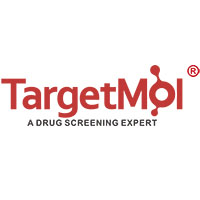| Name | PJ34 hydrochloride |
| Description | PJ34 hydrochloride (PJ34 HCl) is a potent specific inhibitor of PARPl/2. |
| Cell Research | PJ34 is dissolved in 100% DMSO at 10 mM and then diluted in DMEM without serum[1]. PC12 cell cultured are grown in Dulbecco's modified Eagle's medium supplemented with 5% (v/v) fetal calf serum, 5% (v/v) horse serum, and a 1% (v/v) penicillin-streptomycin antibiotics mixture. Cells are grown in an atmosphere of 95% air and 5% CO2 at 37°C. For all experiment, cells are seeded at a density of 4×104 cells/well in 96-well culture plates and allowed to attach overnight. For assessment of cell viability, hydrogen peroxide-induced cytotoxicity is quantified by a standard measurement of LDH release with the use of the LDH assay kit. Briefly, 6 h after hydrogen peroxide exposure, 20 μL of medium of each well is collected, and the solution prepared from LDH assay kit is added. After incubation at room temperature for 30 min, the reaction is stopped by addition of 1 N HCl, and absorbance is measured at 450 nm using a microplate reader. |
| Kinase Assay | To assess the PARP-1 or PARP-2 inhibitory activity of FR247304, 3-AB, and PJ34, PARP activity is evaluated with minor modifications. PARP enzyme assay is carried out in a final volume of 100 μL consisting of 50 mM Tris-HCl (pH 8.0), 25 mM MgCl2, 1 mM dithiothreitol, 10 μg activated salmon sperm DNA, 0.1 μCi of [adenylate-32P]NAD, 0.2 units of recombinant human PARP for PARP-1 assay or 0.1 units of recombinant mouse PARP-2 for PARP-2 assay, and various concentrations of FR261529 or 3-AB. The reaction mixture is incubated at room temperature (23°C) for 15 min, and the reaction is terminated by adding 200 μL of ice-cold 20% trichloroacetic acid (TCA) and incubated at 4°C for 10 min. The precipitate is transferred onto GF/B filter and washed three times with 10% TCA solution and 70% ethanol. After the filter is dried, the radioactivity is determined by liquid scintillation counting. |
| In vitro | In peroxynitrite-induced cells (EC 50=20 nM), PJ34 was able to inhibit the onset of cell necrosis. |
| In vivo | In peroxynitrite-induced cells (EC 50=20 nM), PJ34 was able to inhibit the onset of cell necrosis. |
| Storage | Powder: -20°C for 3 years | In solvent: -80°C for 1 year | Shipping with blue ice. |
| Solubility Information | DMSO : 50 mg/mL (150.69 mM), Sonication is recommended.
H2O : 33.2 mg/mL (100 mM)
|
| Keywords | poly ADP ribose polymerase | PJ34 hydrochloride | PJ 34 | PJ 34 Hydrochloride | inhibit | PJ-34 Hydrochloride | PJ34 | PJ-34 | PJ34 Hydrochloride | PJ-34 hydrochloride | Inhibitor | PARP |
| Inhibitors Related | 4'-Methoxychalcone | Niraparib tosylate monohyrate | VPC-70063 | 3-Aminobenzamide | XAV-939 | Niraparib | 3-Methoxybenzamide | NU1025 | Olaparib | Benzamide | Picolinamide | OUL35 |
| Related Compound Libraries | DNA Damage & Repair Compound Library | Anti-Pancreatic Cancer Compound Library | Bioactive Compound Library | Epigenetics Compound Library | Anti-Ovarian Cancer Compound Library | Inhibitor Library | Anti-Cardiovascular Disease Compound Library | Anti-Aging Compound Library | Bioactive Compounds Library Max | Anti-Cancer Compound Library |

 United States
United States



